6 Most Effective Flea and Tick Medications for Dogs in 2024
When it comes to safeguarding your dog from fleas and ticks, finding the right preventative is essential. With so many options available, from monthly chews and topical treatments to long-lasting collars and natural alternatives, it can be challenging to choose the best fit for your pet’s needs. In 2024, pet owners will have access to a range of effective flea and tick medications, each with unique benefits, to provide reliable protection for dogs of all ages, sizes, and activity levels.
This guide covers the top six flea and tick treatments for dogs, highlighting options for every preference—from all-in-one oral preventatives like Simparica Trio to natural ingredient-based sprays like Wondercide. Whether you’re looking for long-term control, affordability, or a gentle option for pets with sensitivities, this list includes the most effective choices on the market today. Read on to explore the features, pros, and cons of each option to help you make an informed decision for your dog’s health and comfort.
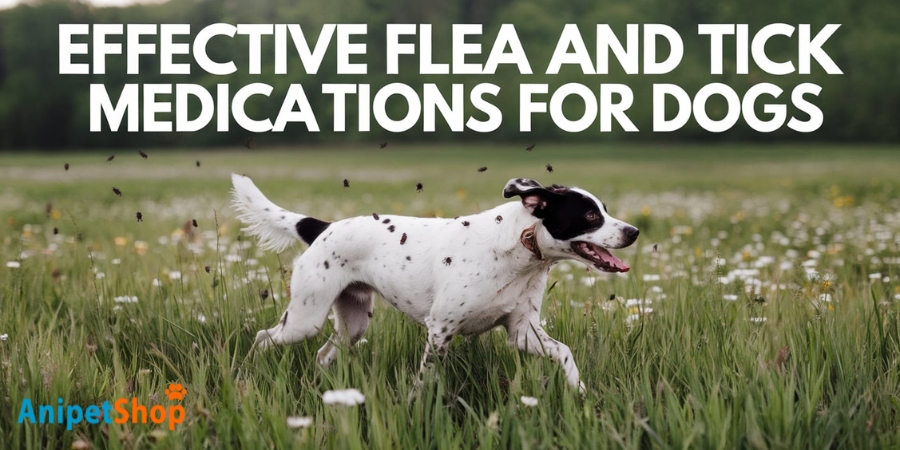
Simparica Trio – Best Overall Flea and Tick Medications
Simparica Trio is a powerful, all-in-one monthly chewable that provides comprehensive protection for dogs against multiple parasites. Safe for puppies 8 weeks and older and weighing at least 2.8 pounds, this prescription-only medication targets fleas, ticks, heartworms, roundworms, and hookworms, making it one of the most complete parasite preventatives available.
Why We Recommend Simparica Trio:
- Broad-Spectrum Parasite Control: Simparica Trio covers fleas, five types of ticks (including Gulf Coast ticks, deer ticks, American dog ticks, lone star ticks, and brown dog ticks), as well as heartworms, roundworms, and hookworms. This makes it an excellent choice for pet owners seeking a single product to handle a range of parasite threats.
- Tick Protection for Lyme Disease Prevention: For dogs that frequent wooded or high-tick areas, Simparica Trio offers added peace of mind. It’s FDA-approved to help prevent infections that could lead to Lyme disease, and its effectiveness against multiple tick species makes it ideal for outdoor-loving dogs.
- Convenient Monthly Dosing with Added Flexibility: Each dose of Simparica Trio offers 35 days of protection, giving pet owners a few extra days should they forget to administer it at exactly the 30-day mark. This flexibility can be a relief for busy schedules, ensuring your dog remains protected month-round.
- All-in-One Approach: Simparica Trio eliminates the need for multiple medications by combining flea, tick, and heartworm prevention into one chewable. This convenience can be especially helpful for dogs that are difficult to medicate or for owners who want to simplify their pet’s health routine.
- Easy Administration: The chewable tablet is liver-flavored, making it more palatable for dogs. It can be given alone or with food, making it an easy addition to your dog’s monthly regimen.
While Simparica Trio offers extensive protection, it comes at a higher price point, especially for larger dogs. For owners looking for a more budget-friendly option, Sim
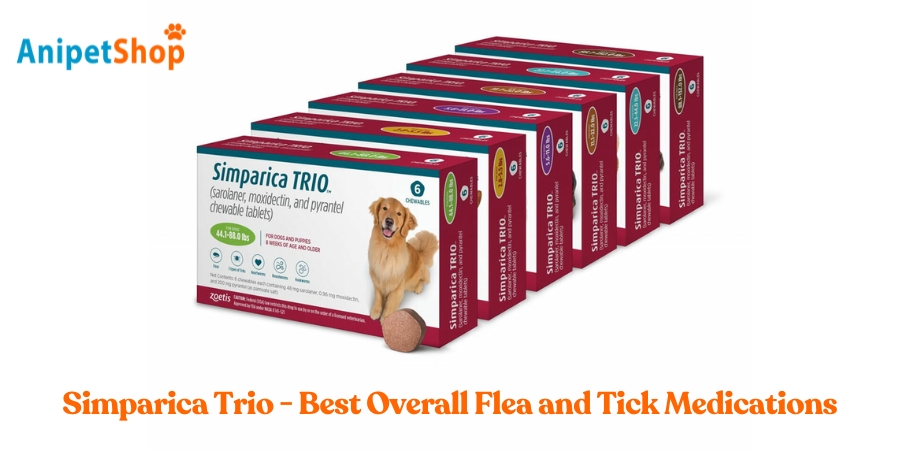
parica also offers a chewable that protects against fleas and ticks only, without heartworm and intestinal parasite coverage.
Simparica Trio’s blend of comprehensive parasite protection, ease of use, and proven effectiveness makes it our top choice for pet owners looking to safeguard their dog’s health in a single, convenient treatment. For active or adventurous dogs, the added tick protection is especially valuable.
Pros:
- Effective against fleas at all life stages
- Provides protection from five tick species
- Covers heartworm, roundworm, and hookworm prevention
- FDA-approved to prevent Lyme disease-causing infections
Cons:
- Higher cost compared to the regular Simparica chew
Specs:
| Feature | Simparica Trio |
| Kills Fleas | Yes |
| Kills Ticks | Yes |
| Kills Flea Eggs and Larvae | No |
| Repels Fleas | No |
| Repels Ticks | No |
| Prevents Heartworm | Yes |
| Other Parasites | Yes (Roundworms, Hookworms) |
| Repels Mosquitoes | No |
| How Long to Work | Kills fleas within 4 hours and ticks within 8 hours |
| Taste | Pork-liver flavor |
| Waterproof | Yes, since taken orally |
| Active Ingredient | Sarolaner, Moxidectin, Pyrantel |
| Side Effects | Vomiting, diarrhea, lethargy, anorexia, seizures in some cases |
| Dosing | 1 tablet per month |
| Application Type | Chewable Tablet |
| Age | Dogs 8 weeks and older weighing at least 2.8 pounds |
| Manufacturer | Zoetis |
| Safety | The safe use of Simparica TRIO has not been evaluated in breeding, pregnant, or lactating dogs |
| Duration of Effectiveness | 30 days |
| Price | Generally higher per dose compared to similar products |
| Clinical Studies | Demonstrated high effectiveness in clinical trials |
| Storage Instructions | Store at or below 30°C (86°F) |
Refer to Simparica Trio price at Anipetshop:
| Simparica Trio | |
| Simparica Trio for Dogs 2.8-5.5 lbs | $65.00 – $126.00 |
| Simparica Trio for Dogs 5.6-11 lbs | $60.00 – $128.00 |
| Simparica Trio for Dogs 11.1-22 lbs | $75.00 – $230.00 |
| Simparica Trio for Dogs 22.1-44 lbs | $77.00 – $230.00 |
| Simparica Trio for Dogs 44.1-88 lbs | $79.00 – $230.00 |
| Simparica Trio for Dogs 88.1-132 lbs | $81.00 – $230.00 |
Attention: Prices below are for reference only and may change over time !
Simparica Trio For DogsBravecto Topical Solution and Chews for Dogs
Bravecto provides 12 weeks of flea and tick protection with just one dose and is available with a vet’s prescription. Pet owners appreciate the affordability and convenience of three months of continuous coverage. Many find the chewable form easy to give, with the flavor and small size making it simple to disguise as a treat—especially helpful for smaller dogs who struggle with larger pills. For dogs that prefer a non-oral option, Bravecto also comes as a 12-week topical solution, which is typically about $10 less than the chew.
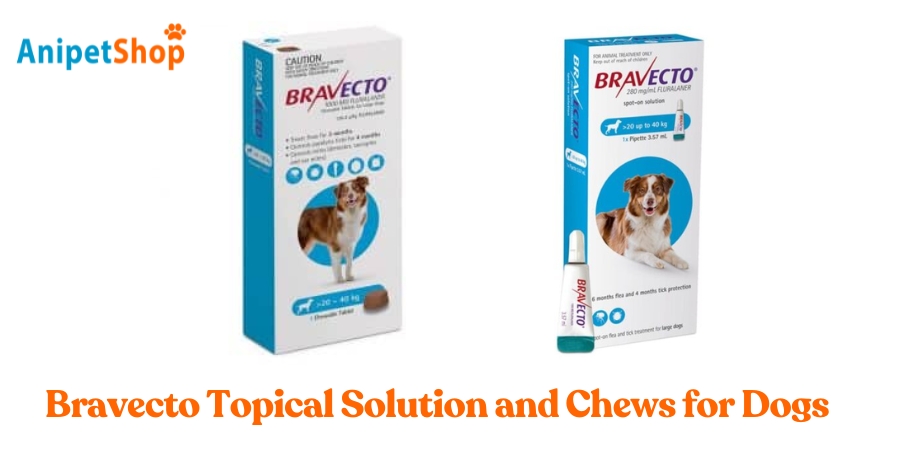
For tick protection, Bravecto covers black-legged ticks, brown dog ticks, American dog ticks, and Asian long-horned ticks (in the chewable version only) for the full 12 weeks. However, it only protects against lone star ticks for up to eight weeks, an important consideration if these ticks are common in your area.
Pros:
- Cost-effective, providing 12 weeks of flea and tick protection
- Offers protection against the Asian long-horned tick (chewable form only)
- Available in both oral and topical forms for flexibility
Cons:
- Loses effectiveness against lone star ticks after eight weeks
Specs:
| Feature | Bravecto |
| Kills Fleas | Yes |
| Repels Fleas | No |
| Kills Flea Eggs and Larvae | Yes |
| Kills Ticks | Yes |
| Repels Ticks | No |
| Repels Mosquitoes | No |
| Prevents Heartworm | No |
| Protects Against Other Parasites | No |
| Waterproof | Yes – taken orally |
| How Long to Work | 2 hours to kill fleas and 12 hours to kill ticks |
| Taste | Tasty flavor |
| Active Ingredient | Fluralaner |
| Dosing | 1 tablet lasts up to 12 weeks |
| Age | Dogs ages 6 months and up |
| Manufacturer | Merck Animal Health |
| Safety | Safe for breeding, pregnant, and lactating dogs |
| Side Effects | Vomiting, diarrhea, lethargy, decreased appetite |
| Duration of Effectiveness | 12 weeks |
| Price | Generally higher per dose, due to longer duration |
| Clinical Studies | Demonstrated high effectiveness in clinical trials |
| Storage Instructions | Store below 30°C (86°F) |
Refer to Bravecto price at Anipetshop:
| Product | Package Size | Price |
| Bravecto Chew for Small Dogs (4.4-9.9 lbs) | 1 Chewable Tablet | US$56.00 |
| Bravecto Chew for Medium Dogs (9.9-22 lbs) | 1 Chewable Tablet | US$58.00 |
| Bravecto Chew for Extra Large Dogs (44-88 lbs) | 1 Chewable Tablet | US$60.00 |
| Bravecto Chew for Large Dogs (22-44 lbs) | 1 Chewable Tablet | US$59.00 |
| Bravecto Chews for Dogs (88-123 lbs) | 1 Chewable Tablet | US$65.00 |
| Bravecto Topical For Dogs 4.4-9.9 lbs (2-4.5 kg) | 1 Dose | US$51.00 |
| Bravecto Topical For Dogs 9.9-22 lbs (4.5-10 kg) | 1 Dose | US$52.00 |
| Bravecto Topical For Dogs 22-44 lbs (10-20 kg) | 1 Dose | US$55.00. |
| Bravecto Topical For Dogs 44-88 lbs (20-40 kg) | 1 Dose | US$55.00 |
| Bravecto Topical For Dogs 88-123 lbs (40-56 kg) | 1 Dose | US$62.00 |
Attention: Prices below are for reference only and may change over time !
Bravecto For DogsNexGard Chewables for Dogs – Best Oral
NexGard Chewables are a convenient long-term flea and tick control option, featuring a tasty beef flavor that dogs love. Pet owners report that the chews are easy for dogs to eat, even for smaller pups, thanks to their soft texture and manageable size. NexGard Chewables are safe for dogs and puppies as young as 8 weeks old, provided they weigh at least 4 pounds.
Administered once a month, NexGard starts killing fleas within just four hours and is FDA-approved for Lyme disease prevention, making it a valuable option for long-term control. NexGard targets five tick species—American dog ticks, lone star ticks, deer ticks, brown dog ticks, and black-legged ticks—providing thorough tick coverage for dogs who frequent tick-prone areas. For additional protection, NexGard also offers a Plus formula that includes heartworm and internal parasite prevention, ideal for pet owners seeking all-in-one monthly protection against multiple threats.
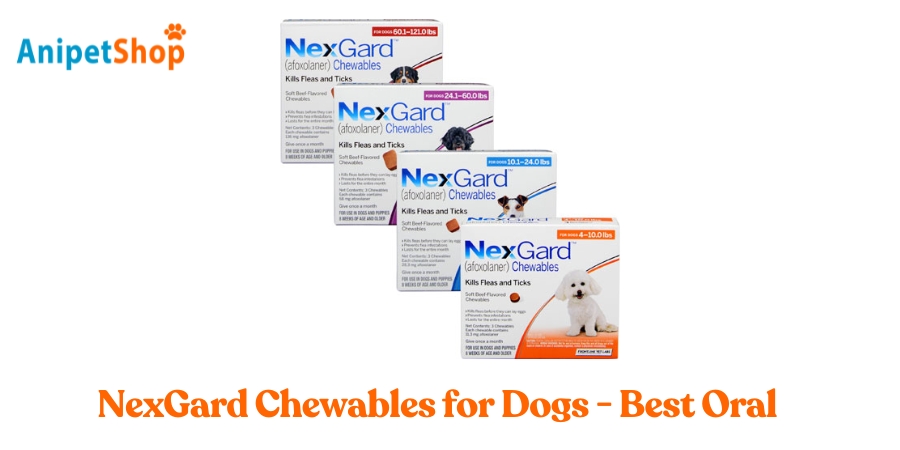
This monthly dosing approach simplifies parasite control, ensuring consistent, comprehensive protection. Regular dosing of NexGard supports a flea- and tick-free environment for dogs year-round.
Pros:
- Tasty, soft chew with a beef flavor
- Convenient size for smaller dogs
- FDA-approved for Lyme disease prevention
Cons:
- Higher cost for large dogs compared to many topical options
Specs:
| Feature | Nexgard |
| Kills Fleas | Yes |
| Kills Ticks | Yes |
| Kills Flea Eggs and Larvae | Kills fleas before they can lay eggs |
| Repels Fleas | No |
| Repels Ticks | No |
| Prevents Heartworm | No |
| Other Parasites | No |
| Repels Mosquitoes | No |
| How Long to Work | 4 hours to kill fleas, 24 hours for ticks |
| Taste | Beef flavored |
| Waterproof | Yes, since taken orally |
| Active Ingredient | Afoxolaner |
| Dosing | 1 tablet per month |
| Application Type | Chewable tablet |
| Age | Puppies 8 weeks and older, weighing more than 4 lbs |
| Manufacturer | Boehringer Ingelheim |
| Safety | Not evaluated for use in breeding, pregnant, or lactating dogs |
| Side Effects | Vomiting, diarrhea, lethargy, rare neurological effects |
| Duration of Effectiveness | 35 days |
| Price | Moderate per dose |
| Clinical Studies | Demonstrated high effectiveness in clinical trials |
| Storage Instructions | Store at room temperature 30°C (86°F) with excursions permitted up to 40°C (104°F). |
Refer to Bravecto price at Anipetshop:
| Product | Package Size | Price |
| NexGard Chewables for Dogs 4-10 lbs | 3 Chews | US$61.00 |
| NexGard Chewables for Dogs 10.1-24 lbs | 3 Chews | US$65.00 |
| NexGard Chewables for Dogs 24.1-60 lbs | 3 Chews | US$59.00 |
| NexGard Chewables for Dogs 60.1-121 lbs | 3 Chews | US$67.00 |
Attention: Prices below are for reference only and may change over time !
Nexgard Chewables For DogsComfortis Chewable Tablet – Safer Flea and Tick Option
Comfortis™ is a monthly chewable flea prevention option that veterinarians often recommend for dogs with seizure concerns, as it may be a gentler choice than some other flea treatments. However, it’s essential to consult with your veterinarian before starting any new medication, especially if your dog has a history of seizures or other health issues, as each pet’s needs are unique.
Comfortis works by quickly eliminating fleas, starting to kill them within 30 minutes and achieving 100% effectiveness in about four hours. This rapid action provides immediate relief for dogs suffering from flea infestations and offers ongoing monthly protection. However, while Comfortis is highly effective against fleas, it does not target ticks or tick-borne diseases. For dogs in tick-heavy regions, it’s important to consider additional tick prevention.
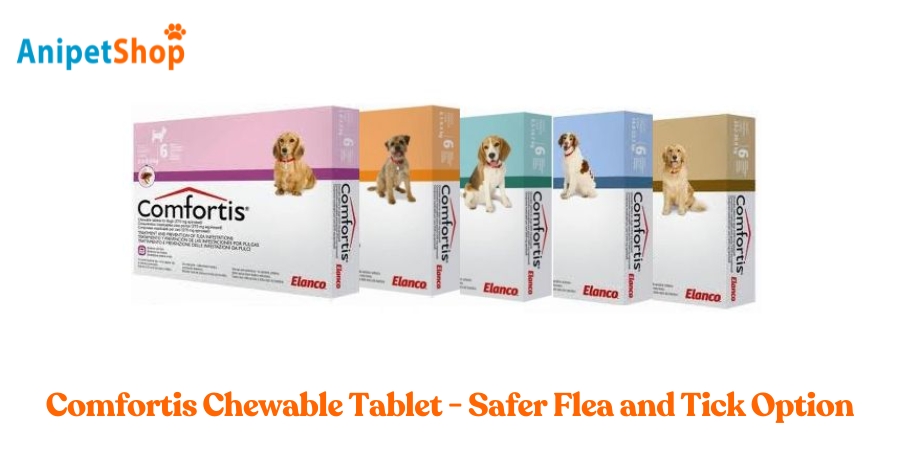
Safe for dogs 14 weeks and older, Comfortis is easy to administer and comes in a beef-flavored chew that many dogs find palatable. Its once-a-month dosing schedule simplifies flea control, making it easy to remember and incorporate into your pet care routine. For pet owners seeking a reliable, fast-acting flea solution without tick coverage, Comfortis provides a trusted option that may be suitable for dogs with specific health sensitivities.
Pros:
- Considered safer for dogs with a history of seizures
- Effectively protects against fleas
- Approved for use in puppies as young as eight weeks
- FDA-approved for safety and efficacy
Cons:
- Lacks tick prevention
Specs:
| Feature | Comfortis |
| Kills Fleas | Yes |
| Repels Fleas | No |
| Kills Flea Eggs and Larvae | No |
| Kills Ticks | No |
| Repels Ticks | No |
| Repels Mosquitoes | No |
| Prevents Heartworm | No |
| Protects Against Other Parasites | No |
| Waterproof | Yes – taken orally |
| How Long to Work | Begins to kill fleas in 30 minutes |
| Taste | Beef flavored |
| Active Ingredient | Spinosad |
| Application Type | Chewable tablet |
| Dosing | 1 tablet per month |
| Age | Dogs and cats 14 weeks and older |
| Manufacturer | Elanco Animal Health |
| Safety | Not yet evaluated for use in breeding, pregnant, or lactating dogs |
| Side Effects | Vomiting, lethargy, anorexia, weight loss, and diarrhea. |
| Duration of Effectiveness | 4 weeks |
| Price | High per dose |
| Clinical Studies | Demonstrated high effectiveness in clinical trials |
| Storage Instructions | Store at between 68°F and 77°F |
Elanco Seresto Flea and Tick Collar for Dogs – Best Collar
The Seresto Flea and Tick Collar by Elanco is a practical and budget-friendly solution, particularly for dogs that resist oral medications. Unlike monthly treatments, the Seresto collar provides up to eight months of continuous protection against fleas and ticks with just one application, making it a convenient, over-the-counter choice for pet owners looking for long-lasting control.
One key advantage of the Seresto collar is its water resistance. Dogs can wear it during baths or swims without compromising its effectiveness, although its efficacy may be reduced if the dog swims or bathes more than once per month. This feature makes it suitable for moderately active dogs who spend time outdoors. The collar is designed to gradually release active ingredients (imidacloprid and flumethrin) onto your pet’s skin and coat, repelling and killing fleas and ticks on contact—without needing the pests to bite first.
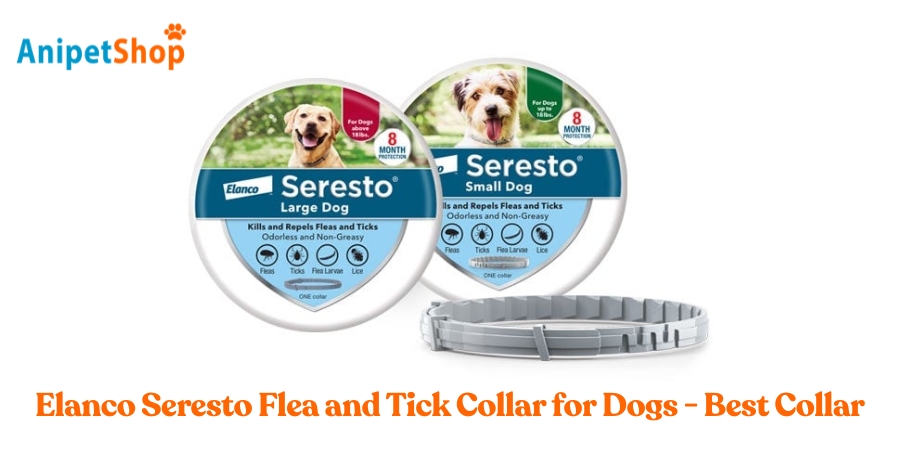
However, it’s essential to prevent pets (or curious children) from chewing on the collar, as ingestion could be harmful. While incidental contact is generally safe, prolonged or direct mouth contact should be avoided. The Seresto collar’s ease of use, long-lasting effects, and affordability make it an excellent choice for many pet owners seeking a reliable flea and tick collar.
Pros:
- Convenient, over-the-counter option
- Provides eight months of flea and tick protection
- Adjustable for a comfortable fit
Cons:
- Not ideal for dogs that tend to chew on their collars
- Reduced effectiveness for dogs that frequently swim or get wet
Wondercide Flea & Tick Spray and Dog Shampoo – Best With Natural Ingredients
Wondercide offers a line of flea and tick sprays and a dog shampoo that provide a natural approach to pest control. These products can be used alongside your dog’s primary flea preventative, offering added protection against pests like ticks and mosquitoes. The key active ingredient, cedarwood oil, is known for its potential to repel fleas and ticks. The spray can even double as a mosquito repellent for both pets and humans, making it versatile for outdoor adventures.
While Wondercide products use steam-distilled essential oils like cedarwood, peppermint, lemongrass, and rosemary, it’s essential to note that natural flea and tick treatments may not have the same effectiveness as traditional preventatives. Experts caution against relying solely on natural ingredients, as there is limited evidence supporting their ability to prevent flea and tick infestations. However, frequent use of natural products can help keep your dog clean and add an extra layer of protection when combined with a vet-recommended preventative.

Wondercide’s spray is available in four refreshing scents—like Lemongrass and Rosemary—and is safe for pets of all ages. The flea and tick shampoo, with a light peppermint scent, is suitable for dogs four months and older. Together, Wondercide’s products provide a gentle, pleasant-smelling option for pet owners interested in incorporating natural ingredients into their pet care routine.
Pros:
- Formulated with natural essential oils
- Available in refreshing scents like Lemongrass and Peppermint
- Offered in both spray and shampoo options
- Safe for pets of all ages
Cons:
- Not advised by vets as a standalone flea and tick preventative
- Scent may be overpowering for some pets
- Needs regular reapplication for continued effectiveness
Finding the right flea and tick preventative is key to keeping your dog healthy and comfortable year-round. Each option in our top six list offers unique benefits, from long-lasting collars to fast-acting chewables and natural sprays. Consider your dog’s specific needs, and consult your veterinarian to choose the most effective and suitable protection. With the right choice, you’ll provide lasting relief from fleas and ticks, supporting your pet’s overall well-being.
FAQs
Do flea and tick preventatives also protect against other parasites?
Generally, products labeled only for fleas and ticks won’t cover other parasites. However, some multi-protection preventatives can also guard against additional threats like heartworms, roundworms, and hookworms. Consult your vet about products that offer broader coverage if your dog is at risk of multiple parasites.
What are the pros and cons of natural versus chemical flea and tick preventatives for dogs?
Natural preventatives often contain essential oils and can be gentler, but their effectiveness is not well-proven. Veterinarians typically recommend using natural products as an extra layer of protection rather than the main defense. In contrast, chemical preventatives have been tested for effectiveness and may provide more reliable protection as the primary preventative.
What should I consider when choosing a flea and tick preventative for my dog?
When selecting a flea and tick preventative, think about the form that best suits your dog’s needs—oral chews, topicals, or collars, each of which varies in how it’s administered and how long it lasts. Also, assess whether your dog requires additional protection, such as heartworm prevention or defense against specific tick species common in your area.
What happens if I don’t give my dog a flea and tick preventative?
Without preventatives, your dog is more susceptible to infections and diseases, including skin infections from fleas and serious illnesses like Lyme disease from ticks. Fleas and ticks can also spread to humans, posing a risk to everyone in the household. Using a preventative helps safeguard both your pet’s health and your family’s well-being.
Lily Watson is an author specializing in veterinary care in Australia. With a profound passion for animal welfare and a solid foundation in veterinary science, Lily has dedicated herself to disseminating valuable knowledge and information for both pet owners and professionals in this field.

